Toronto Neighbourhoods
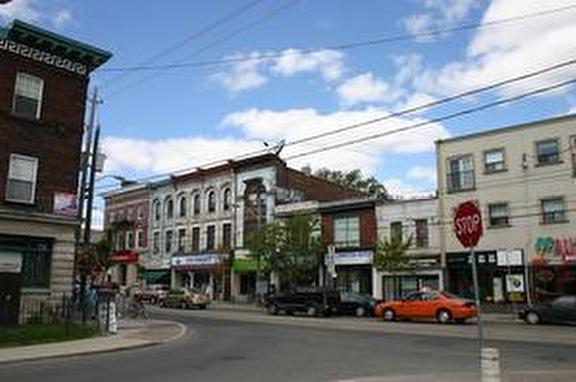
Parkdale Toronto Neighbourhood
Considered one of the more elite neighbourhood's in Toronto in the late 1800s (alongside Rosedale), Parkdale was once known as Toronto's playground by the lake. In 1922, Sunnyside Amusement Park was opened on Parkdale's beach, and at that time it was the place to be in Toronto. Soon came the construction of the Gardiner Expressway, which forced Sunnyside Park to shut down, separating Parkdale from the Lake. Still, Parkdale continues to hold onto its more superior qualities. It is known to have some of Toronto's most vibrant shopping districts, tree-lined streets, affordable homes and impressive mansions. Conveniently, it is also within walking distance of some of Toronto's waterfront parks, and the ever beautiful High Park. Most of the houses in this area reflect the Victorian-era, and can range anywhere from $300K - $700K.
The Grand Mansions in the South Parkdale area were built between 1875 and 1895. For a time, some of these mansions were converted to smaller apartments and bachelor pads, and are now being converted back to single family homes. The houses to the North-end of Parkdale, above Queen Street, were built sometime later between 1900 and 1910.
The main shopping district in Parkdale is located along Queen Street West. Residents also enjoy shopping in the Roncesvalles Village Shopping District, where many delis, bakeries, shops and restaurants can be found. This area has benefited from a new wave of restaurants, shops, cafes, lounges, art galleries, as well as some new condominium developments and loft projects. Parkdale is evolving into the new hip and urban place to live, outside of the Downtown core.
Residents can gain easy access from a multitude of streetcar services offered along Queen, King and Dundas Streets, as well as Roncesvalles and Macdonell Avenues; all which connect commuters to the Downtown core or the Bloor-Danforth Subway line. Motorists are just minutes away from the Downtown core, as well as the Gardiner Expressway and Lake Shore Boulevard. See also Roncesvalles Village.
Queen West Toronto Neighbourhood
Since the 19th Century, this area has been known as Toronto's primary shopping district. Between the mid 19th century to mid 20th century, the area was known as a landing ground for many different immigrants, predominantly European Settlers. As Queen West continued to evolve, it has become home to a very diverse community.
Well known for its Canadian Broadcasting, Music, Fashion and Entertainment pockets, this area has become and International Arts Centre for many tourists and Toronto and area residents alike. The “original” Queen West, which is the area between University and Spadina Avenues, is now lined with upscale boutiques, chain stores, restaurants, tattoo parlours and hair salons. The areas greatest attraction is the broadcast hub, formerly the home of City TV, but currently housing a number of other broadcast stations owned by CTV Media. Other attractions include the famous Eaton Centre, one of the largest indoor malls in North America, and Much Music.
Further west along Queen Street is the site of many institutional and historical buildings, such as Old City Hall, Osgoode Hall and the Four Seasons Centre. This area has been an Arts haven for creative types of all ages. It is also a community with a very “happening” nightlife. This area has seen a new wave of lofts and condos hit its streets, as many of the older commercial and warehouse buildings have been restored.
The Queen West area contains easy-access transportation with the Queen streetcar running right through the heart of the neighbourhood, as well as easy access to the University-Dundas Subway Line.

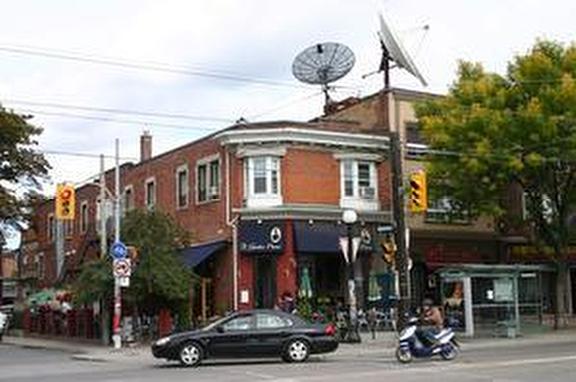
Little Italy Toronto Neighbourhood
A small district located along College Street, this area was once known as the commercial and residential centre of the Italian Community. Today “Little Italy” is considered one of Toronto's most multicultural neighbourhoods. The majority of the area's row and attached Victorian houses were built between 1880 and 1910, and can range between $300K- $700K; most with their parking garages located at the rear of the house. Residents in the area enjoy shopping along College Street, between Shaw Street and Euclid Avenue. The neighbourhood features many authentic Italian restaurants as well as European fashions and delicatessens. The Portuguese Village Shopping District is also located just minutes away along Dundas Street and also features many produce markets, bakeries, shops, restaurants and other cafes.
Still a very family-oriented community, Little Italy is also becoming increasingly popular amongst young professionals. Here, after 8 PM, the streets come alive. It is a trendy strip with a European feel, and also known for its bars, pool halls, lounges, trattorias and some of the best Italian cuisine on this side of the Atlantic. Once known as a mom and pop; pizza and pasta district, Little Italy is now known as somewhat of a 21st Century Club District, and is the host of two summer street festivals.
Little Italy is served by regular bus service along Ossington Avenue, and streetcar service on College, Dundas and Bathurst Streets. Drivers are within ten minutes of Lake Shore Boulevard and the Gardiner. Once upon a time, this area was a toned-down, suburban-like community. Today “Little Italy” is pulsating with energy.
Liberty Village Toronto Neighbourhood
In the late 1700s and early 1800s, these lands were first set aside for military use. The arrival of railway to this area in the 1850s attracted industrial use, which lead to the construction of many warehouses and factories. Today, many of these said factories and warehouses have been converted into the beautiful hip and trendy lofts and condominiums that area residents enjoy. It is said the area was named “Liberty Village” because it is the first ground prisoners walked upon, back in the 1800s, after their release. In 1999, a project ensued to turn this formally vacant industrial space, to new Downtown space, to match its surrounding areas. The Liberty Village area starts west of Dufferin Street, and aims to distinguish itself from Parkdale. Liberty Village has experienced remarkable growth in the last five years, with its new condominium and loft projects, parks, and other projects still under way. The neighbourhood has gone through a massive transformation and offers everything the area developers had promised from the beginning. It offers quiet, yet upbeat and trendy living just outside of Downtown. It has also been labelled, one of the “Hottest” areas in Toronto; a popular neighbourhood for young professionals and people looking for that Downtown life, outside of the Downtown core- yet just a streetcar ride away.
The Village is also known for its success with Art and Design Studios, where many Canadian and US companies have relocated their businesses to, making more work available for many area residents. Many of the business and commercial offices in the area can be found along the West Side of Liberty Village.
Red brick Victorian architecture dominates this street-scape; many with high ceilings, huge windows and exposed brick. Let it be said that King Liberty won the Canadian Urban Institute Brownie Award for best large scale project in 2005. The new glass and concrete condo towers, provide and interesting contrast to the older and more historical warehouse lofts in the area. Homes in this area range from the $200K-$700K.
Residents can take advantage of the waterfront trails used by walkers, joggers, cyclists or in-line skaters. Liberty Village is situated just minutes away from the Entertainment and Fashion districts, and is also in close proximity to the Lake Shore, Gardiner, and other areas of Downtown. The King and Queen Street car lines provide easy transportation access for many area residents, and the 'Exhibition' GO train stop is also within walking distance of this neighbourhood.
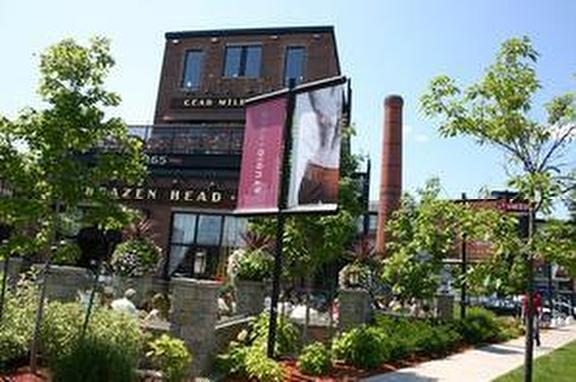
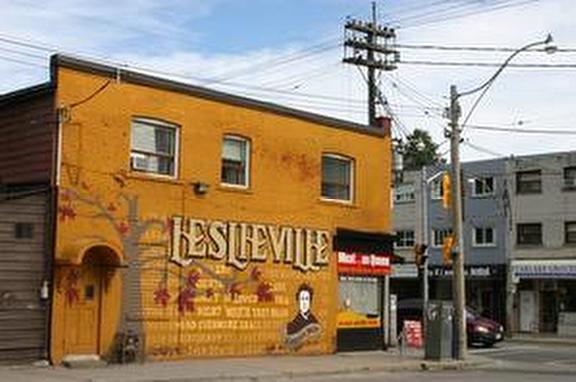
Leslieville Toronto Neighbourhood
Leslieville is a rather calm, quiet and cozy neighbourhood, despite its proximity to the Downtown core. An area that has undergone a lot of developments in the last few years, Leslieville started out as a flourishing market garden in the 1850s. It was a small village which grew up around the Toronto Nurseries, owned by George Leslie and sons (whom Leslieville was named after). The area is known for its older houses- most of which were built in the late 1800s, and consist of Ontario Cottages, Second Empire row houses and Victorian houses; the majority ranging between $200K-$500K. The second generation of houses were built north of Queen Street in the early 1900s; these houses include both semi-detached and detached homes, as well as a great number of bungalows. Some of the bungalows here, are in fact some of the tiniest found in all of Toronto.
When driving into the area, much of the area surrounding Queen Street East, between the Don River and the Beaches may appear a little shabby, due to years of industrial abuse, however, this area is in the process of major gentrification. The area holds a lot of promise. Several condominium and loft projects have either been completed, or are currently underway, leaving this area in a fundamental process of transformation; as well, it is no surprise that new restaurants, shops and cafes are slowing cropping up around the neighbourhood.
This area serves families and young professionals all the same, with its many parks, arenas, schools and community centre. One bonus that has lured residents here over the years is Leslieville's cheaper land. Leslieville offers cheaper and more affordable living, closer to the Downtown area. This has also lured other land developers, which is the reason Leslieville is blossoming into the beautiful neighbourhood it is.
This area's main shopping district is along Queen Street East. Many independent shop owners sell goods which cater to area residents. The area is well served by public transit with both bus and streetcar routes along Carlaw, Jones, Greenwood, Coxwell, and Eastern Avenues, and Queen and Gerrard Streets; most of these connect right to the Bloor-Danforth Subway line. From Leslieville, motorists can reach Downtown within minutes, and Lake Shore Boulevard, the Gardiner Expressway and the Don Valley Parkway are also within range. If you enjoy Downtown living, but also prefer the quietness of Suburban life, Leslieville is where Suburbia meets Urban-living.
King West Toronto Neighbourhood
Once home to many industrial and factory buildings, King West has now become the essence of urban city living. With many Victorian-style town-homes and newly renovated condos and lofts, this area has experienced a major upgrade with new restaurants, cafes, and shops popping up all over the neighbourhood. It is considered a major player in Downtown's food, financial and entertainment scenes. Just minutes from Downtown Toronto, King West is the perfect place for quiet walks in the park; gallery-viewings, trendy bars- and just an overall place to entertain friends. It is the new face of many brand new condo and loft projects. Residents in the area say it is a place to really call home. They say they actually know their neighbours. It is not unusual to see the same faces jogging through the park, walking their dogs, eating a scone at the cafe, or enjoying a drink at the bar. It is a friendly, diverse community and now more than ever, home to many young professionals and up and coming families.
The location offers easy access to some of Toronto's other districts such as the Financial District, Fashion and Entertainment Districts, and other famous destinations such as The Rogers Centre, Exhibition Place, Harbourfront, Fort York and the Toronto Islands. This area does not discriminate. Though it may have a mostly adult vibe, many schools can still be found throughout the neighbourhood. It is very close to the also trendy, Queen West neighbourhood. Area residents can hop on the Bathurst streetcar which connects to the Bloor line, within minutes.
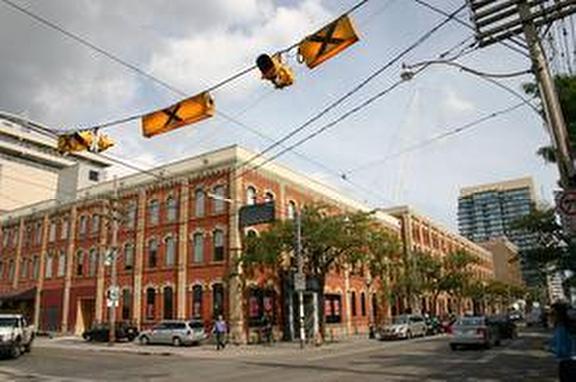
Hillcrest Toronto Neighbourhood
Known to house some of the prettier streets in Toronto, Hillcrest was first inhabited in the 1840s by John Turner, a reformer from England. The Turner house, name “Bracondale” was located where Hillcrest Park is now situated. “Bracondale” was bought by the City, demolished, and turned into the park it is today. The houses in this beautifully well maintained neighbourhood still have that turn of the Century charm, and are a wonderful mix of shapes and sizes. In the North End of Hillcrest, most of the homes were built in the late 1800s – early 1900s. Beside Hillcrest park, a larger pocket of detached homes were also built between the 1910s and 1930s; some of which were built with the original stone from the original Union Station, which was torn down after World War I. These homes range anywhere from the $300K - $1 000 000+.
This well groomed, family-oriented neighbourhood offers a lot to see and do. Its shopping district is located along St. Clair Avenue West. Area residents also take advantage of the shops along Davenport and Vaughan Roads, which happen to be within walking distance. Hillcrest park, one neighbourhood attraction, is perched atop of the Davenport escarpment, offering visitors a wonderful view of the City skyline and Lake Ontario. Aside from the marvellous view, the park's wading pool, outdoor playground and four tennis courts are some other attractions which entice its visitors. Other parks in this area include; Winston Churchill park, Cedarvale park, Christie Pits and Wychwood Park.
Hillcrest is considered a very mature and well established neighbourhood that is conveniently connected to the Downtown area. Although an increasingly popular neighbourhood amongst families, Hillcrest is also popular amongst young professionals, with its martini bars and trendy restaurants.
Travelling to and fro in Hillcrest is fairly easy with the St. Clair Avenue West streetcar running right through the centre of the neighbourhood. Regular bus service can also be found along Oakwood Avenue and Bathurst Street, while Davenport Road offers limited bus service. Within fifteen minutes, motorists can reach Downtown and the Allen Expressway, which connects commuters to other major highways. Hillcrest has a little something for everyone. Whether you enjoy tree-lined road ways and quiet parks, or more eccentric and urban festivities- like Hillcrest's annual Salsa on St. Clair, Hillcrest is the place to be.
Harbourfront Toronto Neighbourhood
Once dubbed as having one of the ugliest waterfronts, Harbourfront has evolved into a beautiful picturesque place to live. This area has probably had one of the biggest facelifts in all of Toronto. With new condominium projects in recent years and many still under way, this neighbourhood, along with its many attractions, has become one of the more preferred places to live and play in Toronto.
Harbourfront's history dates all the way back to when Toronto was first founded, and the Harbour was used for shipping and industrial purposes. The entire area stretches from Yonge Street to Bathurst Street, along Queens Quay. This neighbourhood is separated from the rest of Downtown, by the elevated Gardiner Expressway, but access can still be gained to Downtown within minutes through the Spadina, Yonge/Bay and Jarvis Street off-ramps.
The area's largest attraction is the Harbourfront Centre, which offers Art and Culture from Canada and all over the world. The Harbourfront Centre is located just off the waterfront and provides live shows and entertainment for area residents and visitors, on a daily basis. Often, specialty vendors and merchants can be found selling goods, antiques, food, clothing and other collectibles from tents. Next to the Harbourfront Centre is the Queens Quay Terminal, which is an old warehouse now converted to a multi-use shopping centre designed for high-end retailers, commercial office space, and a residential condominium development. This building has also been a favourite for many tourists visiting the area.
Residents can gain easy access to the Entertainment District and other areas of Downtown by foot. Also, Toronto's number one attraction, the CN Tower is just steps from Harbourfront, along with the Rogers Centre (home of the Toronto Blue Jays), and Air Canada Centre (home of the Toronto Raptors and Toronto Maple Leafs). Harbourfront is also home to Maple Leaf Gardens, Molson Amphitheatre (Concert Theatre) and a network of parks and open trails. This area is served by the 509 and 510 streetcars from Union Station (where one can also board the GO Train to head out of the City). For many years this area has been home to families, young professionals and business professionals.
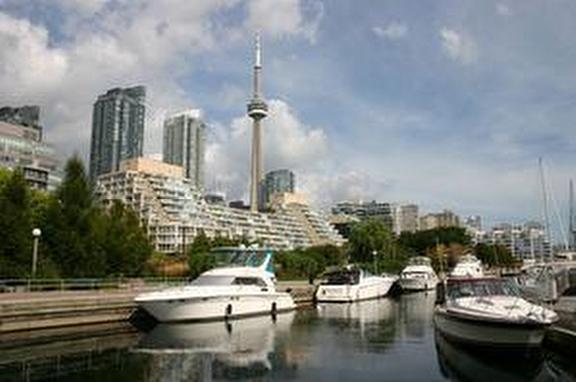
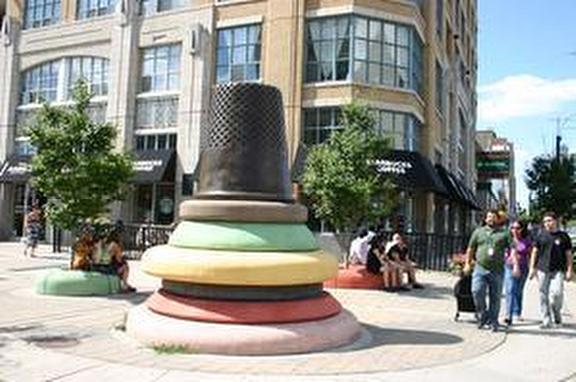
Fashion & Entertainment District
Located on Spadina Avenue, between Dundas and Front Streets, this district now labelled as the Fashion District, was once home to dozens of garment factories. Today, few garment factories remain. This beautiful fashion outlet, housed in beautifully refurbished warehouses, contains the largest concentration of fabric and fashion accessories in all of Toronto. Centuries ago, Native trappers traded fur with English traders on these lands. Today, some of Canada's largest designers and companies have made this district home, occupying space in the office towers located on some of the Fashion District's side streets.
The residential part of this neighbourhood can be found along Queen Street, closer to Bathurst, where there is a mix of cafes, restaurants and grocers. The intersection of Queen and Spadina is famous for its lofts and condos, with some new developmental projects under way. This area, also considered a part of the Downtown West neighbourhood, is considered one of Toronto's most lively neighbourhoods. It is also within close range of the King/Spadina/Bathurst District, Toronto's Entertainment District and Queen West. Not long ago, there were not as many residential options in the Downtown West area, until rezoning of many of the commercial buildings into residential lofts have made way for newer condominium and loft projects, for business and young professionals moving into the area.
The Entertainment District located on Wellington Street, between Spadina Avenue East to Yonge Street, is home to both Royal Alexandra and Princess of Wales Theatres. Other area attractions include Roy Thompson Hall, Second City Comedy Club, Wayne Gretzky Restaurant, the famous Scotia Bank Theatre (formerly known as Paramount Theatre), Air Canada Centre and The Rogers Centre. It is a popular spot for trendy restaurants, cafes and bars, and also a lively night spot for night clubs and upscale lounges. Due to the popularity of both areas, some of the housing can range anywhere from the $800K-$1 000 000+, though you may be fortunate enough to find a condo or a loft for considerably cheaper. If downtown is where you have your heart set, this is one area you don't want to miss!
Distillery District Toronto Neighbourhood
Where History meets entertainment- The Distillery is Canada's largest Centre for Arts and Culture. In the 1800s, this District was the largest distillery in the entire British Empire. Founded by William Gooderham and James Worts, they produced gallons of Whiskey and Spirits from this site. Today the area is known for its various cafes, restaurants and shops. The Distillery District is comprised of 13 acres, housing more than 40 Heritage buildings, 10 streets and the largest collection of Victorian-style architecture in all of North America. It is a shopping-haven for not only residents, but tourists as well. Despite the closing of the Distillery's operations in 1990, the area still operates as a Pedestrian-only Village, dedicated entirely to Arts, Culture and Entertainment. These cobblestone streets are lined with some of the finest galleries in all of Toronto. The neighbourhood's unique ambiance has made way for over 3,000 television and film shoots, since the 1990s. Some of the other attractions in this area are the Yonge Centre for Performing Arts and the Soulpepper Theatre Company.
This area has been extremely popular amongst young professionals, with its various Art lofts, condos and newly renovated town-homes scattered throughout the neighbourhood. Three new condo projects are currently underway; one completed, and two almost sold out. The towers are said to reflect shimmery glass with wrap around balconies and panoramic views; quite the contrast from the “European” look and feel in which the rest of the District appears to emanate, but they shall be a lovely contribution to the area.
Though the area has brought in a large influx of young professionals, it is still considered a kid friendly neighbourhood. Just steps from the Downtown core and other areas such as St. Lawrence Market, public transit is easily accessible, and the Gardiner Expressway, Lake Shore Boulevard, Don Valley Park Way and Union Go Train Station can be reached within minutes.
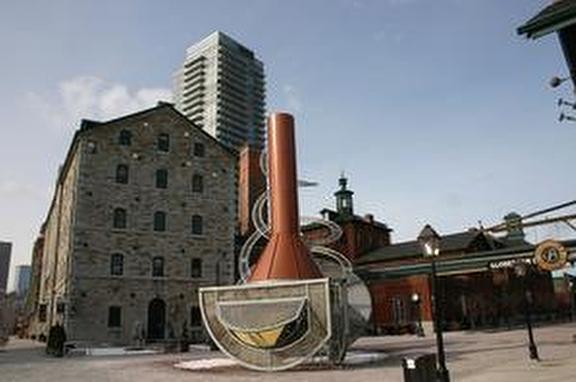
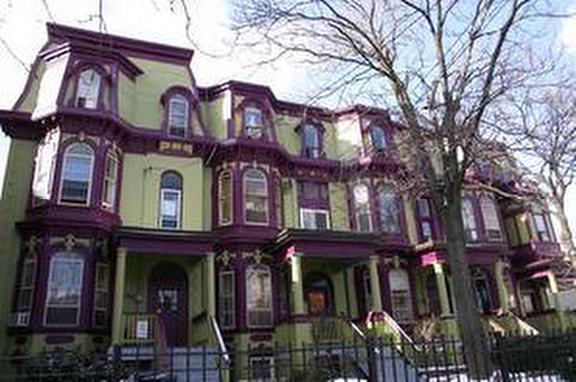
Cabbagetown Toronto Neighbourhood
This area, bordered by two historic cemeteries and the Don Valley, was once known as one of the poorest areas in Toronto. Now an established residential and family oriented community, this area is known for its attractive 19th Century-Style homes and lavish gardens. Cabbage Town is known to have the largest continuous area of preserved Victorian homes in all of North America.
This diverse area is home to many Artists, Musicians, Journalists and Writers; but is also home to many Doctors, Professors and Social workers- some, who are affiliated with the nearby University. Here, it is not uncommon to find small coffee shops and discount stores along one street, and million dollar Victorian style homes around the corner. The area has many schools, parks, and other attractions, such as The Allan Gardens and Riverdale Farm.
Located on the east side of Downtown Toronto, Cabbage Town is within walking distance from the Downtown core, and just steps away from the Church and Wellesley Community. Other areas of Downtown can also be reached easily by streetcar, which is the same streetcar that will take you to Kensington Market. Although a more family oriented community, Cabbage Town still has its fair share of restaurants, cafes and outdoor patios.
Old Cabbage Town, located near the corner of Parliament and Carlton Streets, is known to host a large number of Victorian homes, some of which have been converted to bed and breakfasts for tourists who visit the area. While here, feel free to take part in the 90 minute walking tours, which display a community of beautiful houses and other neighbourhood attractions. Cabbage Town is also a vibrant dance community, and is home to many of Toronto's well known Dance Theatres and Schools. The neighbourhood is an extremely diverse community; where friendliness meets peculiarity. Anyone can call this wonderful and historic area home, and the beauty of it is, Cabbage Town is right in the centre of it all.


